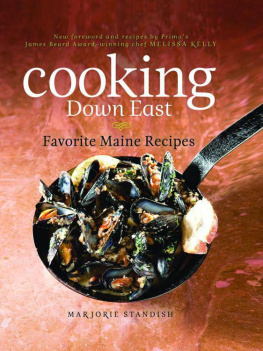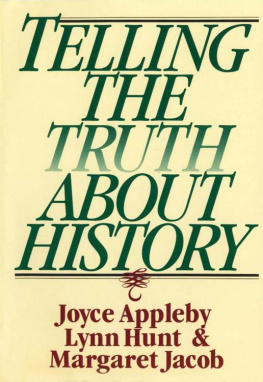Published by American Palate
A Division of The History Press
Charleston, SC
www.historypress.com
Copyright 2019 by Sharon L. Joyce
All rights reserved
E-Book year 2019
First published 2019
ISBN 978.1.43966.740.8
Library of Congress Control Number: 2019936995
print edition ISBN 978.1.46713.802.4
Notice: The information in this book is true and complete to the best of our knowledge. It is offered without guarantee on the part of the author or The History Press. The author and The History Press disclaim all liability in connection with the use of this book.
All rights reserved. No part of this book may be reproduced or transmitted in any form whatsoever without prior written permission from the publisher except in the case of brief quotations embodied in critical articles and reviews.
To my son Jeffrey, with whom I share a lifetime pursuit of learning new things.
INTRODUCTION
The way life should be.
Maine slogan
So, where is Downeast Maine? Downeast Maine is usually considered the area along the coast consisting of Hancock and Washington Counties. Downeast is a nautical term meaning that if you were sailing from Boston or other southern areas in New England you would sail downwind and east to arrive on the eastern coast of Maine. Ok, it is a bit confusing. But there is another saying in Maine: You cant get there from here. Maine is a place where roads end or begin, depending on how you look at it. Small towns, good people, some not particularly fond of those city types, various traditions and an interesting history of foods. There are treasures of natural beauty and interesting people.
You can lose yourself in thought in the natural beauty of Acadia National Park and walk along the rocky coast as you watch lobstermen haul their traps.
As you begin this book, you are probably wondering what was trending in the 1700s or if one had know at least two gelatin-based recipes in the 1950s and 1960s to be considered a good cook. What immersions and infusions were essential to Native American recipes? Perhaps you have thought about what your tastes and family background bring to what you eat. Are you influenced by foods where you live?
Maine slogan, The way life should be. The Fourth of July parade in the Village of Bar Harbor. Authors collection.
Maybe you are just wondering what to have for dinner tonight or how the foods you eat affect your health.
Why is cooking too much work for some and a therapy for others? I am in neither category. I am a lifetime learner of many things. Cooking, eating, gathering together are what we build our lives around, so why not learn as much as we can about food? I have empathy for those who are overwhelmed by the number of untested recipes and food blogs that dont lead to a good final result. Hopefully, you dont give up and are happy with your mistakes. Humor is helpful.
A woman who stopped by the cooking school said she didnt cook at all. However, if she did cook, she would only be interested in new food cooking. She wanted to be on the cutting edge of the things she didnt do. And who is to say she wasnt? Things change, but the basics are there and, for the most part, have been there. We, as Americans, want to be the first and best, but toasting bread is toasting bread. A toaster is a toaster even though it may be bigger or a different color or faster.
I am from away. Even though I have lived in Maine for over thirty years and my son was born here, I am not considered to be from Maine. Even if you are born in Maine, you may not be considered from here by those who are from here. I do, however, have an even longer connection to Maine. When I was little, I loved lobster and would want lobster when my family went to a nice restaurant. I dont remember them ever saying that it was too expensive, even though we didnt have a lot of money. When I was in fifth grade, I had to pick a state to write a report on, and I chose Maine. I busily glued lobster shells and potato pieces on a poster and knew I had to go to Maine someday. Maine is not usually on your way somewhere else. Coming to Downeast Maine is usually a destination trip, as you are not passing through Maine to go somewhere else. So, when I had an opportunity to actually come to Maine, I took it. I stayed.
This is an understanding of the ingredients of the foods that come together in a recipe. It has been a fascinating journey for me. Why do you care about what the first inhabitants were eating or how they adapted in this new area later called Downeast Maine? It is a part of understanding yourself and opening up to creative thinking. Looking at more than a package of food at the store. It is a story about planning, organizing and stopping to think about what we eat.
THE FOODS THAT THE NATIVE AMERICAN FIRST SUMMER VISITORS FOUND ON MOUNT DESERT ISLAND
How the Ingredients Were Used and the Wisdom that Has Been Forgotten over the Years
And so it began. Many think Native Americans in Maine, as well as all indigenous people, most likely came across the Bering land bridge from Siberia to Alaska that connected the continents thirteen thousand years ago. After the ice age, there was a slow migration into various areas of the Americas, and according to the Abbe Museum in Bar Harbor, there is evidence of Native American life on Mount Desert Island over ten thousand years ago. The first to settle here were called People of the Dawn, as those who live in this area of Maine are the first to see the sunrise in the country.
Obviously, they must have learned to look for water, certain plants and animal tracks as well as some method of catching fish during their migration. They passed down this information from generation to generation by word of mouth.
It is sometimes difficult to imagine a life without any traditional job. Their job in life was based on figuring out how to find food and shelter.
Corn is a good example of learning from history. Corn started in Peru, where you will find that a number of foods are thought to have originated. There is evidence of corn in the tombs of Peru as food offerings to gods and woven into fabrics and clay. It is believed that corn was cultivated by Native Americans for centuries before the European explorers arrived. The seeds and planting methods were passed on from tribe to tribe. There was wisdom in their methods of planting. Corn was sowed with a small fish for fertilizer, and beans were grown next to the newly sprouted grain so that the legumes could climb the stalks. Squash was planted near the bottom of the two for shade, weed reduction and providing nitrogen to the soil. This method of planting was called Three Sisters, indicating that the three sister plants worked together to provide food for the family or tribe. Known Native American dishes like corn bread, grits, corn pudding, roasted corn and hoe and Johnny/journey cakes were part of Wabanaki culture for thousands of years. There is a wild plant in Mexico called teosinte, and it has some characteristics of modern corn. Teosinte has a hard outer shell, and when put in a fire, it pops, becoming our first form of popcorn. Pumpkin and squash were being used before the colonists arrived, and even some of these may have originated in Peru before starting their journey through America. Beans were cultivated such a long time ago it is difficult to know where their wild ancestors came from.













